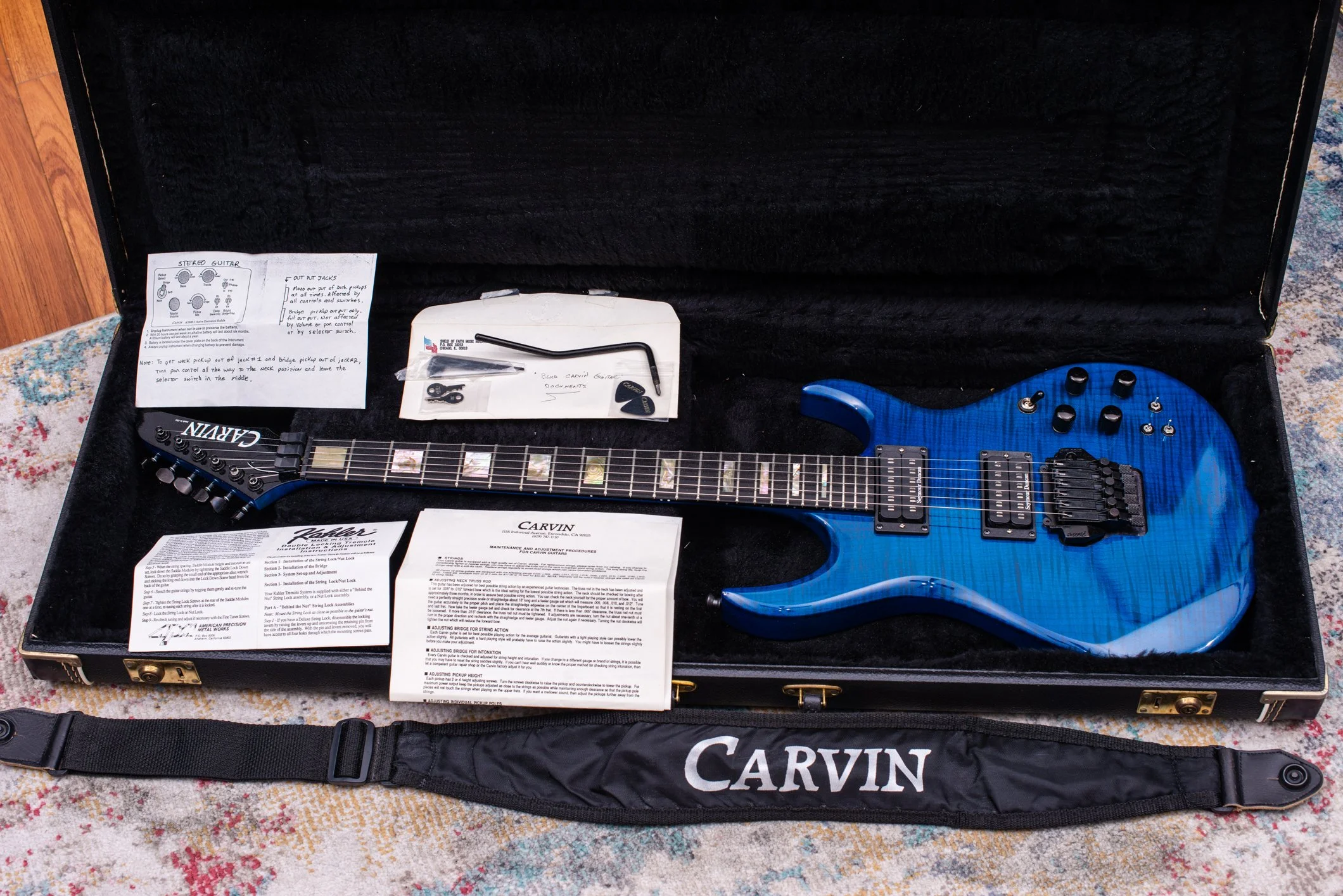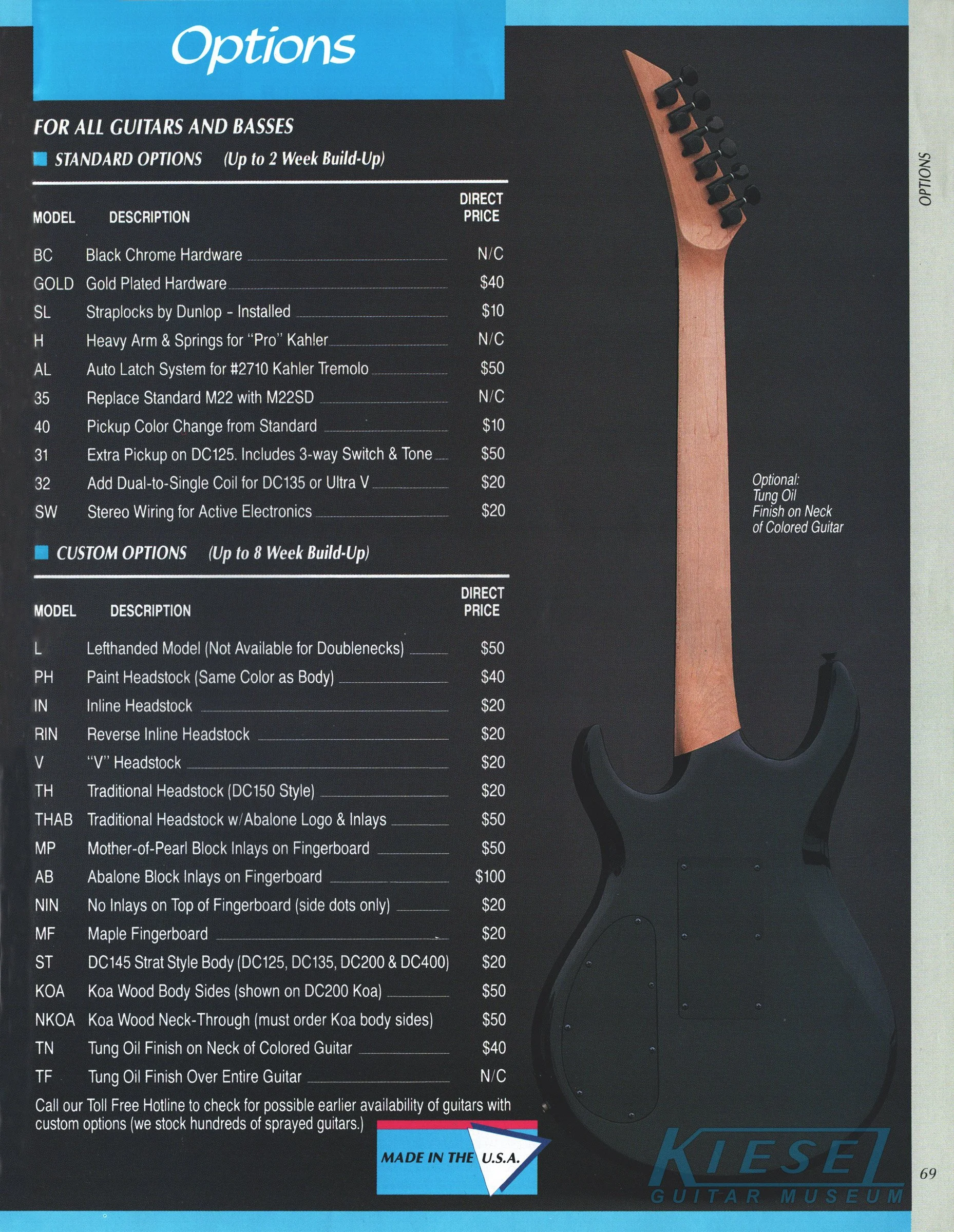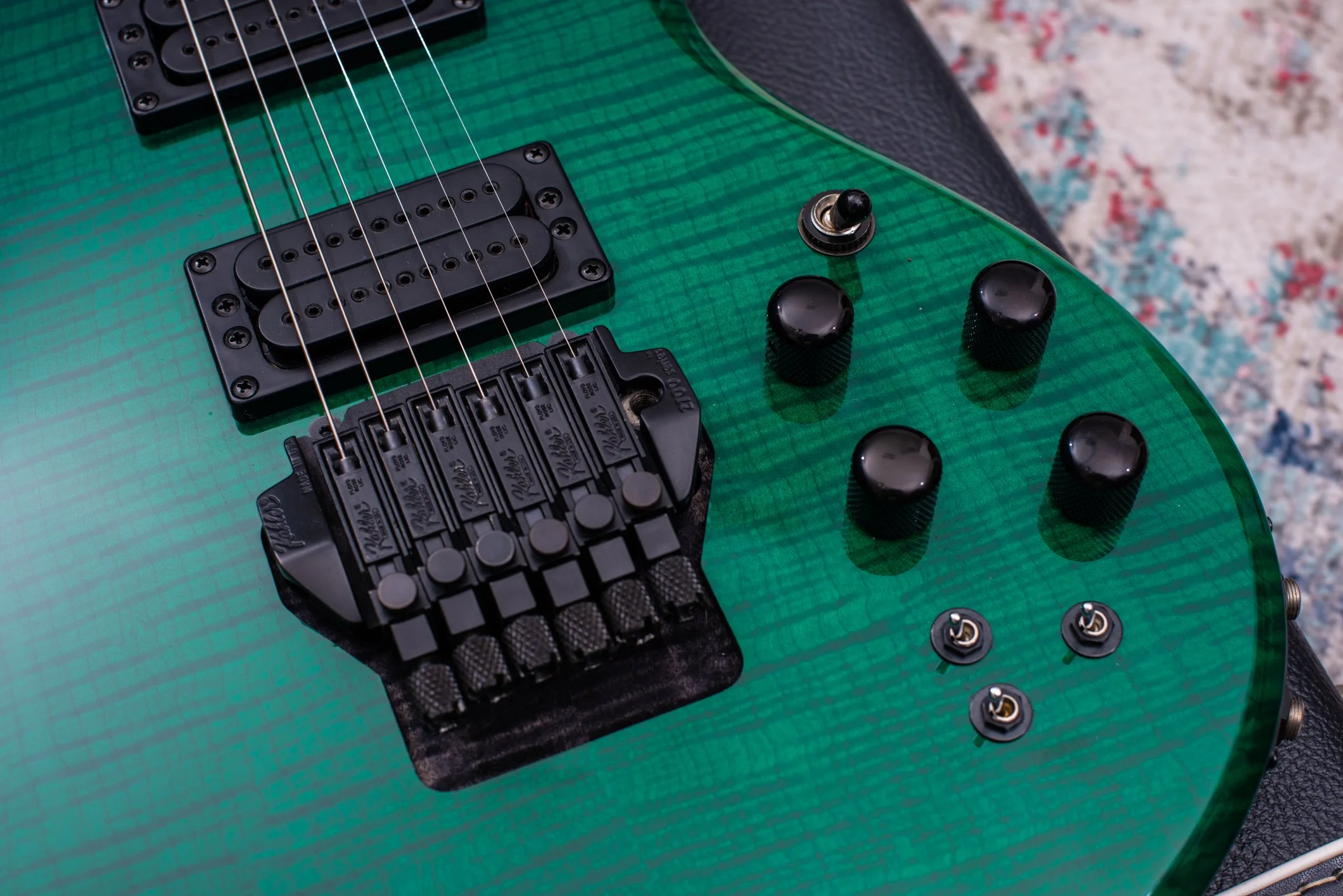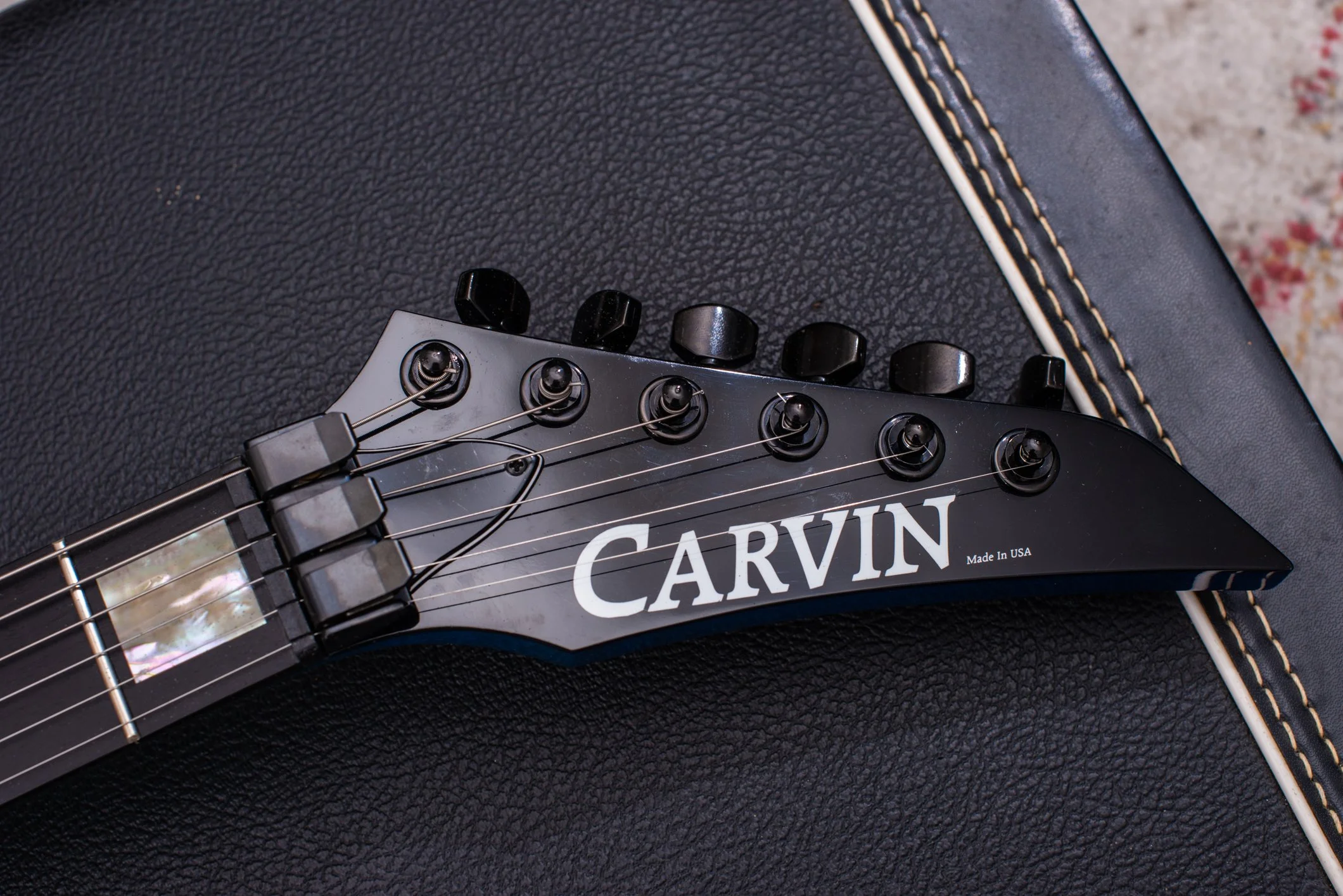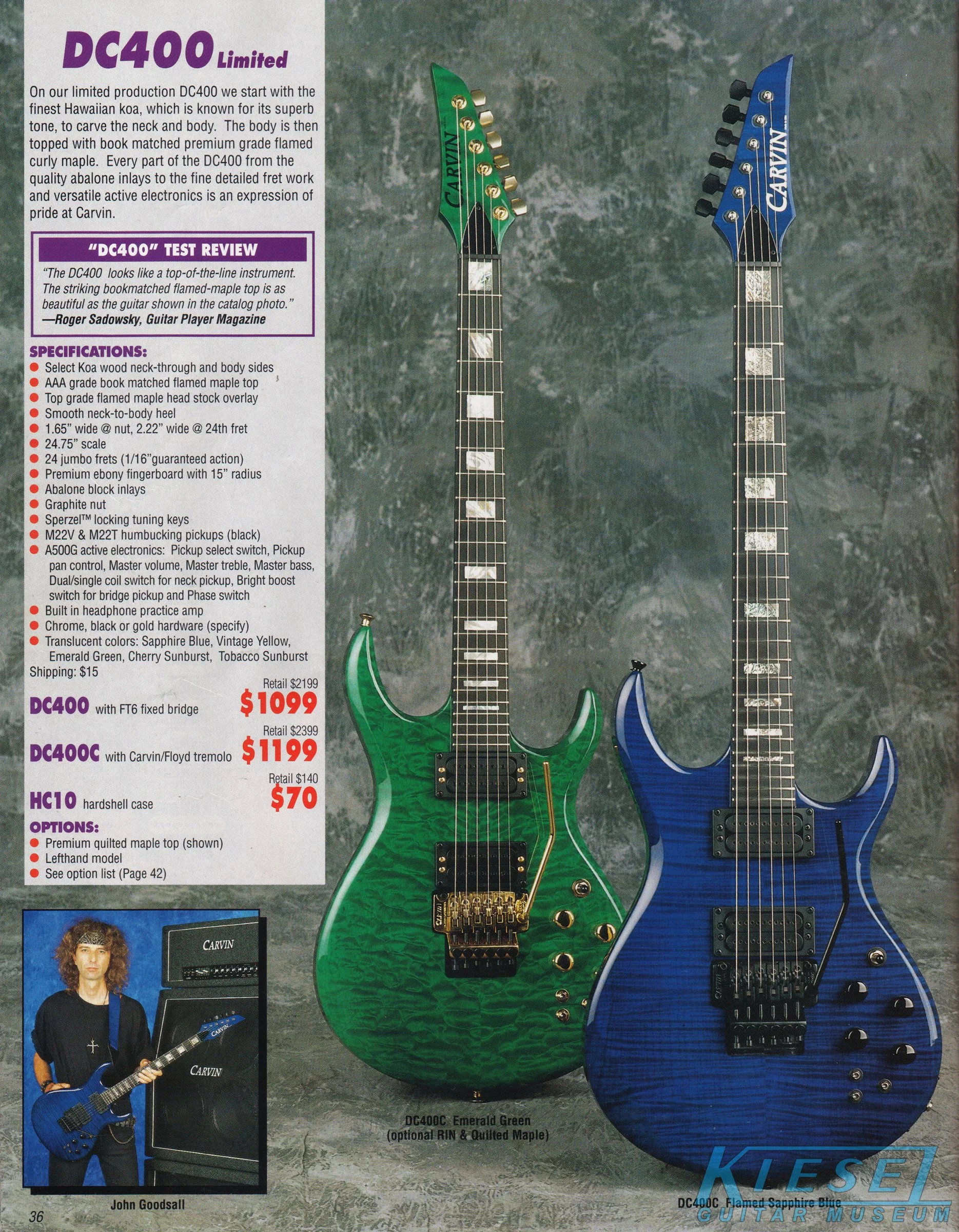I occasionally look for old pointy headstock Carvins but they seem to rarely come up for sale, so when I spotted a green 1990 DC400 one evening I was thrilled. I looked through the pictures to check the condition but I was already pretty sure I was going to buy it, but then I got to the last picture in the listing. Next to the green one was another, very similarly optioned blue DC400 - not yet listed for sale. Luckily, the shop that had these was located near me here in Florida so I set an alarm and called them immediately when they opened the next morning to ask about it.
Lucky for me, they still had both of them and I worked out a cash deal over the phone. Later the same afternoon, I took a long afternoon drive down to DB Music where I picked up both guitars.
These two were clearly well cared for, both kept in cases with no major blemishes to speak of. That’s quite a feat considering how fragile these pointy headstocks can be. Much of the original paperwork is intact, along with (slightly dryrotted) Carvin straps and nice condition hard cases. Modifications are minimal, but more on that later.
I should also add some context for those unfamiliar with Carvins at this time. These were made to order instruments from a list of available options. These options changed over time and some builds take longer than others, much like any other guitar custom shop. However, they were priced very aggressively, comparable to standard production line USA made guitars of the time. It’s a great value prospect and I’m always surprised they didn’t sell a lot more of them, but part of the factory direct style means you wouldn’t see these in a store unless you lived near the Carvin showroom in California. Without budget models and a thinner artist roster than others, I really just think people didn’t know about them or were afraid to risk mailing a thousand dollar check across the country in an era that long predates common internet sales.
From a modern standpoint as a collector, the biggest drawback for me besides the difficulty in finding these instruments is simply that a lot of options someone else might’ve chosen are ones that I find mediocre, or at worst actively dislike. For example, a relatively common option I’ve seen is to have the back of the neck tung oiled - I hate this on an otherwise glossy neck through guitar. I know this trend has had a popular resurgence recently but I think it looks cheap to simply tape off a line at the neck heel and headstock and leave a big chunk of the guitar unfinished or with a different finish. Example in the below catalog picture, which also gives a sampling of some options available on any guitar model (some options were also model specific).
So of course, finding two DC400’s, the top of the line model, with pointy headstocks (a rarity already), and most importantly without any bad option choices is very exciting for me.
Let’s run through them in detail now. First, a few things that both of them have in common. Since they are both DC400’s, they have highly flamed maple tops with a nice transparent gloss finish that really shows off the wood grain. Both have real abalone block inlays on an ebony fretboard with a 14” radius, black hardware, weigh a ton, and have push-tab style locking nuts. They both have the “1990+” headstock shape, which replaced the previous “Jackson style” pointy. However there is a transition period here, likely depending on order or build time, because both of these guitars have 1990 style headstocks but options like the Kahler Killer which was only available in 1989. My more standard model DC125 has a serial number in between these two DC400’s but has the old Jackson-style pointy headstock. That guitar was probably built and shipped a lot faster than these because it didn’t have custom woods, bridges, or a figured top.
Both of these guitars are neck-through construction and feature 24.75” scale necks. This scale was only available from 1979-1992, and if you wanted a pointy headstock on that scale length it was only 1988-1991.



The most unique option that they both share is the bridge choice, which is a Kahler 2710 Killer. This was Kahler’s absolute top of the line bridge for 1989 and was only made for one or two years before being discontinued. It’s technically part of the 2700 series alongside the 2760 Steeler, which is roughly equivalent to a real OFR, and the 2720 Spyder, which is a more budget oriented model. These were all made in the USA too, though that means your 6mm whammy bars won’t fit (these use Imperial sized arms). The Killer also has a unique feature called the “autolatch” which can set the bridge to a fixed state by simply turning the trem arm, so the Killer trem arms also have a piece at the bottom of the threading that is flat which turns a mechanism related to this. Usually neat little gimmicks like this get forgotten, parts lost, and then you pay through the nose if you even want to try it (I see that $189 autolatch on whammyparts), so it’s also really lucky that both of these guitars had the correct whammy bars AND autolatch pieces, plus paperwork and screws, in the cases. Really awesome find and another sign that somebody really cared about these instruments.
Okay, now for the differences, starting with the green one. This guitar has a few really special options, and it has a later serial number so it’s probably a bit further into 1990 than the blue. Easily noticeable is the reversed headstock, but it also has a color matched flame maple cap on the headstock to match the body top. The black Carvin logo is a little hard to read but looks great in the right light.
In addition, the body and neck is made from Koa, which was a $100 option for 1989 but standard on the DC400 by 1990, so it’s hard to know if this was ordered specifically or not. Either way, it looks great up close but it’s a bit darker than alder or maple would be especially in a color like green which naturally shifts a bit darker. The neck is also a very odd 2-piece design, which I’ve only seen on other Carvins of this same era. Usually multi-piece necks are 3 pieces or some other odd number so that each piece flexes against the other and that adds stability to prevent twisting, or at least that’s the idea. I’m not sure how much worse a 2-piece neck might be but there is no sign of twisting or warping and this guitar is at least 35 years old now so it seems stable enough to me.
Electronics are all stock on this one, with M22 humbucking pickups and the stock active electronics circuit intact. The controls have a good effect on the sound without being unusable at the extremes, so it’s nicely balanced. I did have occasional noise issues with it through certain amps and pedals though, so there is probably an impedance mismatch that doesn’t play nice with certain equipment. This also changes the controls a bit from what I normally expect when I see this arrangement. There is one master volume knob, then a “pan” knob that can be used with the stereo output jacks to separate which pickup output goes to which, or combine them together… not sure how to use that feature effectively but it’s interesting. The bottom two knobs are bass and treble, which can both boost and cut those frequencies, and there is a very nice feeling tactile detent in the middle position to let you know when you are at flat EQ. It has a 3-way toggle switch for the pickups, and 3 additional mini-toggle switches which can take the pickups out of phase or split the coils of the neck and bridge humbuckers respectively. Confusingly, the coil tap controls are called “Bright” for the bridge and “Deep” for the neck, but it’s clear listening to the amp that it’s simply a single coil mode.
Now for the blue one. This guitar has a black painted, non-reversed headstock, with the large white Carvin logo. This look was actually pretty cool and there’s a reason they brought this option back nearly two decades later (the “large” logo wasn’t available for some time).
The body and neck are both maple, with the neck being very highly flamed which looks fantastic. It’s a little more flamed on one side than the other, but it happens to the side facing you when playing so I really can’t complain. Unlike the other one, this is a one piece neck although the headstock does have a second piece glued on to make the pointy shape. The light color of the maple also means the blue comes out very bright and contrasty which looks great.
This one has been modified a bit in the electronics area. The active electronics have been discarded and the Carvin M22’s it originally would’ve come with are also gone. Instead there is a pair of Seymour Duncan PATB-3 Blues Saraceno pickups, the same pickup in both bridge and neck positions. I’ve used this pickup before and really loved in the neck position, but not as much in the bridge, and I still feel that way here. I just like the standard PATB-1 a lot, which I have a spare of, so I’ll probably swap that in at some point. I do love the idea of an H-H guitar with both pickups being PATB’s. With the active electronics gone, it has a more traditional control scheme much like the DC200 model of the same era. That’s two volumes, two tones, and a 3-way selector switch. For the moment, one mini toggle is a phase switch, one coil splits both pickups, and the third is disconnected. I’ll probably rewire it so that each pickup can be split separately by their own mini-switch, the same way my Koa DC200 is set up.
That’s about it. Really awesome guitars that play and sound great. I’ve played older Carvins before, in fact one of my first ever experiences with guitars in general was when I was just starting out in high school and my computer science teacher brought in a 1985 Carvin DC200, white with gold hardware, and a Tom Sholz Rockman for me to play a few times during class. I feel that if Kramer, Jackson, Charvel, etc took Fender as their source DNA to built into super-strats, Carvin came at it with a bit more of a “Gibson” influence. Basically, instead of taking a lightweight SSS bolt-on and putting humbuckers and big frets on it, they took a heavy Les Paul and trimmed it down a bit. When the Carvin DC200 launched in 1981, it was a 24.75” scale set-necked guitar, which evolved from the earlier DC150/160 and CM series (which was a single-cut LP style), so that backs up my thoughts there.
One last picture I found while doing some research - the catalog photo for the DC400 in 1992 features two guitars - one blue, one green with a reversed headstock. There are lots of differences (scale length, bridge, headstock shape, quilted tops, gold hardware) but I thought it was cool how similar this catalog page is to this pair.
More pictures and information available on each guitar’s collection page, links below:

